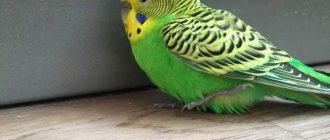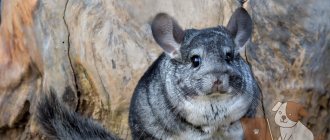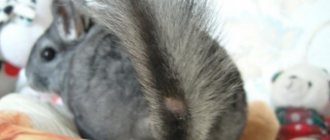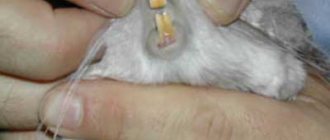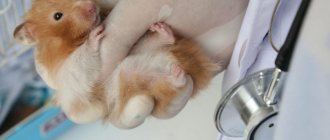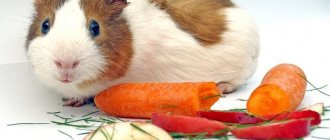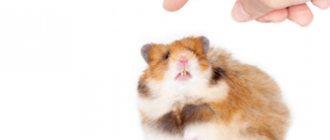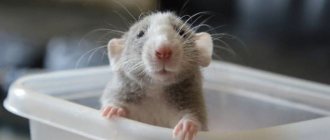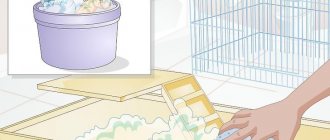- home
- Chinchilla
- Health
03/21/2019 The little chinchilla pleases its owners with its cheerfulness and funny character. But she also has problems. They can relate to such an unpleasant phenomenon as convulsions. It is important to learn how to provide first aid to your pet if there are signs of illness.
Chinchilla has diarrhea
The medical name "enteritis" is one of the diseases caused by poor diet. Chinchillas often “ask” for something tasty from fresh fruits or vegetables. But if you give animals a treat, stomach upset will inevitably occur.
Symptoms of the disease will be:
- softening of droppings;
- fur stained with feces;
- the appearance of an odor from feces.
Every chinchilla owner has encountered this disease. Therefore, the “what to do if a chinchilla has diarrhea” technique has long been worked out. First of all, the animal is put on a strict diet of hay and water. In this case, no grain or other food is given.
Since severe dehydration occurs with diarrhea, it is necessary to ensure that the chinchilla drinks. If the animal is very ill, you will have to force-feed it from a syringe. Instead of water, you can give a decoction of oak bark. It is not recommended to use pharmaceutical drugs without the supervision of a veterinarian due to the animal’s weight being too low.
If the veterinarian prescribed antibiotics, suspecting an infectious disease: salmonellosis, then after a course of treatment the chinchilla needs to restore the gastrointestinal flora. To do this, you will have to use the droppings of a healthy chinchilla, fill it with water, and, after infusing for 30-60 minutes, “give” the infusion to the sick animal. Bacteria released from the gastrointestinal tract along with droppings will quickly restore the intestinal flora of a sick chinchilla.
Recovery after illness
If a chinchilla does not eat or drink for several days, this leads to inevitable weight loss. During the period of recovery from illness, proper and balanced feeding is very important to avoid exhaustion and death of your furry pet. If a chinchilla has not drunk anything for a long time and refuses water, it must be artificially watered from a syringe without a needle. During one drinking session, up to seven milliliters of liquid are injected into the animal’s mouth. It is good to feed the animal dairy-free oatmeal, to which you can add a little calcium. Porridge is fed twice a day - morning and evening.
If the chinchilla refuses to eat on its own, you can inject a little porridge through a syringe into the animal’s cheek.
After using medications, the liver inevitably suffers. To restore normal liver function, you can use the drug Karsil. The course lasts one month. The animal is given three times a day, one-fourth of the tablet dissolved in water. It is also good to take a course of vitamin Gamovit injections. For chinchillas, subcutaneous administration of 0.5 ml of the drug once a day is enough. Minimum - five days. If appetite and activity are completely restored, you can stop injections. Gamovit can be replaced or used together with Catozal, which improves the metabolic process in the body. Catozal is also placed subcutaneously in the withers area, once a day for five days.
It is recommended to use Lactobacterin or Bifidium as probiotics. Half the ampoule is mixed with ten milliliters of water and soldered through a syringe at a time. The probiotic helps well in normalizing intestinal function and eliminates all the negative consequences of antibiotic use. You can also use the probiotic Vetom 1.1. Dosage - dissolve a gram or two of the drug in two teaspoons of water and drink it through a syringe twice a day.
Constipation
The disease is the opposite of diarrhea and often occurs in chinchillas due to eating dry food with a lack of water. Because of this, it is necessary to ensure that water is always freely available to animals.
Since a chinchilla cannot singe, over time the animal’s belly swells. Through the abdominal wall you can feel the intestines with hard feces. When constipation occurs, pain occurs, and the animal begins to take care, becoming lethargic and inactive. Chinchillas refuse food.
In this case, you can no longer manage with a simple diet. What to do if your chinchilla is constipated:
- several times a day, forcefully feed the animal 1-2 ml of liquid petroleum jelly;
- Vaseline oil enemas;
- make the animal move.
Vaseline oil is not absorbed by living organisms, passing through the entire intestine and covering the walls of the gastrointestinal tract with oil. This oil will not cause any harm. Movement improves gastrointestinal motility.
In advanced cases, chinchillas are given injections of Cerucal 0.3 ml twice a day.
On a note! It is very rare, but there are cases of constipation due to swallowed wool.
Typically, chinchillas do not swallow fur because they do not lick themselves like cats. But if the animals are poorly maintained, dead wool can get into the feed and be eaten. The second option for fur getting into the chinchilla’s gastrointestinal tract is a fight with another animal. If the intestines are really blocked by a hairball, you can use Malt paste. But to do this, you must first make sure that the disease arose due to fur and there are no other reasons.
Flatulence
This disease is a direct consequence of feeding succulent food to chinchillas by loving owners. Especially feeds with a high sugar content. In the animal's intestines, these feeds begin to ferment, releasing gas. Chinchillas are not adapted to excreting gases through the anus, which is why flatulence or bloating develops. Symptoms of this disease in chinchillas:
- firm round belly;
- pain when touching the abdomen;
- lethargy, the animal prefers to lie down;
- refusal of food;
- hard breath.
The latter may be a sign of another disease. You cannot cure bloating on your own. Treatment should begin as quickly as possible and only under the guidance of a veterinarian.
Poisoning
The disease occurs when feeding spoiled food. Symptoms of poisoning in chinchillas are very similar to signs of a foreign body getting stuck in the throat.
Poisoning:
- urge to vomit;
- lethargy;
- possible bloating or diarrhea;
- vomit;
- Foam and mucus flow from the animal’s mouth and nose.
When a piece of wood or other object that the animal used to entertain itself gets stuck in a chinchilla’s throat, the symptoms are very similar:
- gagging or vomiting;
- salivation;
- sneezing;
- mucus and foam from the mouth and nose.
It is very difficult to independently determine the cause of a chinchilla’s disease, so if such symptoms appear, the animal must be taken to a veterinarian as quickly as possible.
Urinary system disease
Cystitis usually affects adults. Both males and females are equally susceptible to the disease. The first signs of cystitis are problems with urination, anxiety, the animal bites its sides, squeaks often, and becomes inactive. If signs of illness appear, you should immediately consult a doctor. Self-treatment of the disease without prior examination can only harm the animal. Very often, the internal cause of cystitis is sand or even kidney stones.
Rectal prolapse
The disease is often a consequence of constipation and the animal’s attempts to cough or very intense diarrhea. This picture looks creepy: 1-2 cm of bloody rectum falls out of the chinchilla’s anus. If measures are not taken immediately, the intestine dries out in the air and the disease ends in tissue necrosis.
The intestine must be immediately lubricated with antibiotic ointment to prevent drying out and infection by pathogenic microorganisms. After which the animal is taken to the veterinary clinic. It is better if the chinchilla’s intestine is corrected by an experienced doctor.
Mastitis
If there are microcracks on the nipples of a whelping chinchilla, staphylococcal bacteria, the causative agents of mastitis, can penetrate through them. Mastitis usually occurs after whelping, although the disease can develop without whelping. Symptoms of mastitis:
- redness of the breast;
- elevated temperature;
- pain while feeding babies.
The disease is treated with frequent massages of the mammary gland, since it is unlikely that it will be possible to squeeze antibiotic ointment into the nipple. Size too small. If possible, you can try to milk the diseased gland.
Important! You cannot take away the cubs from a female, the situation will only get worse.
General injections of antibiotics of the penicillin group can help, but the antibiotic will get to the puppies with the mother's milk. Therefore, here every animal owner makes his own choice.
Hair ring
A specific disease of males. A ring of fur sometimes forms on the penis, squeezing the penis. It is not difficult to determine the presence of such a ring:
- lethargy;
- refusal of food;
- lack of urination;
- upon examination, the penis is visible sticking out;
- the tip of the penis turned blue.
The ring must be removed as soon as possible. If the fur is “fresh”, the penis is lubricated with Vaseline or oil and the ring is carefully removed. If the fur has already dried to the penis, you will have to carefully cut the ring with nail scissors.
Hooks on teeth
These formations usually occur due to a malocclusion, when the teeth meet at the wrong angle. The disease is usually genetic.
Important! Chinchillas with malocclusion should not be allowed to be bred.
The second case of the occurrence of hooks is a lack of solid food in animals. Chinchillas' teeth grow constantly. This is a common feature of all actively gnawing animals. If the animal does not have the opportunity to grind down its incisors, the teeth grow and begin to injure the tongue.
If there is not enough solid food to chew or due to an incorrect bite, the back teeth can also grind down incorrectly, forming sharp edges that hurt the animal’s cheeks and palate.
Signs of hooks on a chinchilla's teeth:
- refusal of food;
- exhaustion of the animal in the absence of symptoms of other diseases;
- salivation.
A chinchilla breeder will not be able to cope with this problem on his own, since the hooks on the teeth must be removed surgically.
Conjunctivitis
Poor maintenance can cause animals' eyes to become clogged with dust or irritated by mold spores. Conjunctivitis can be either mechanical or infectious. With mechanical damage, a speck of dust gets into the eye and the animal’s tears begin to flow.
Interesting! Tears are a protective mechanism against mechanical irritants of the eyes.
What to do if your chinchilla's eyes are watery:
- check for debris under the eyelids;
- rinse eyes with saline solution;
- apply antibiotic drops.
If there are no specks, but your eyes continue to water, this is most likely the beginning of an infectious disease. In this case, it is better to go to the veterinarian to find out the reasons, while the inflammation is still weak and the eye has not festered.
A more severe form of conjunctivitis is purulent.
Very often this is a sign of a general infectious disease resulting from hypothermia and weakened immunity. Local diseases caused by pathogenic microorganisms include inflammation of the lacrimal canal. This disease is usually closely related to the malposition of molars. If an animal constantly develops hooks on its back teeth, you must be prepared that sooner or later the tear duct will also be blocked.
On a note! When the tear duct becomes inflamed, not only the eye festers; purulent discharge also appears from the animal’s nose.
What to do if a chinchilla’s eye festers:
- Before examining the veterinarian, carefully wipe the animal’s eyes with a decoction of calendula, chamomile or other suitable infusion;
- go to the veterinary clinic to determine the cause of the disease;
- follow your doctor's recommendations.
Self-medication here can only do harm, since in case of a general illness it is not the symptoms that need to be treated, but the cause. And if the tear duct is clogged, it will be difficult for the chinchilla breeder to clear it due to the small size of the animal. In addition, tooth extraction may be required.
How to treat a runny nose in a chinchilla
If we exclude the above cases of mucus from the nose, a runny nose in a chinchilla may occur as a result of hypothermia. In this case, the body’s defense systems weaken and the animal gets sick with what is commonly called a cold. In fact, this is the activation of certain pathogenic microorganisms when favorable conditions occur.
Symptoms of the disease will be:
- sneezing;
- body temperature is above 38°C, while the normal physiological temperature in chinchillas is 36.1-37.8°C;
- runny nose;
- general depression of the animal.
Often the very first sign of the disease is sneezing. But sneezing can be a simple reaction to dust or some irritating odor. If the animal sneezed a couple of times and stopped there, you don’t have to worry.
But if the animal sneezes a lot, it is necessary to take action. What to do if your chinchilla sneezes:
- to measure the temperature;
- clean the cage thoroughly;
- If the animal's temperature is elevated, contact your veterinarian to prescribe a course of treatment.
Given the general fragility of these animals, the first thing to do if your chinchilla gets sick is to contact a veterinarian. Provided that you can find a specialist in these rodents. Otherwise you will have to act at your own peril and risk.
A runny nose can also be caused by an allergic reaction to any irritant. Allergens are difficult to identify even in humans, so in the case of a chinchilla, the easiest way is to completely change the bedding and food and thoroughly wash the cage. But most often the problem is mold fungi found in low-quality hay.
The sounds they make
When communicating with children, a chinchilla may make a sound similar to whining. She may also whine when she is bored or when someone of the opposite sex is nearby. When a pet whines, but does it less often and sharply, it means that he is looking for something or asking, for example, to open the cage, give him food, or if the cub is lost.
If a chinchilla is interested in something, it will squeak easily and quickly. She makes this sound especially often when she runs around the apartment and new premises, since there is a lot of interesting things around. When a male shows interest in a female, he begins to grunt frequently, thereby indicating this
He also begins to beat his tail, trying to attract attention. In response, the female may react aggressively, she will begin to quack loudly and sharply, and if the male does not stop pestering her, she may even bite him
At this moment it is better to monitor their behavior.
Seizures in a chinchilla, what to do
A fairly common disease in chinchillas, with various causes. Due to the fact that seizures can occur for various reasons, their treatment and prevention are also carried out using different methods.
Signs of seizures:
- sometimes seizures begin suddenly, but there are cases when the animal shows increased activity before the attack;
- directly during an attack, the chinchilla falls to the floor, shakes, and its head may throw back.
Seizures can hardly be confused with any other disease.
Causes of seizures and ways to stop them:
- hypovitaminosis: lack of B vitamins. Introduce a small piece of very dry dates or raisins into the diet (1-2 berries per day);
- hypocalcemia. Take a course of calcium gluconate and add yogurt to your diet;
- hypoglycemia. Increase the calorie content of feed or start feeding young animals;
- stress. Eliminate irritating factors and administer sedatives;
- epilepsy. The use of special medications prescribed by a doctor;
- spinal injury. It cannot be eliminated, it can only be prevented. If you don't drag the animal by the tail too harshly.
When caught by the tail, you can damage the animal's spine and thus provoke seizures.
First aid for seizures:
- warm up and calm the animal;
- inspect the chinchilla for any external damage;
- give an injection of dexamethasone in a dose of 0.1 ml;
- give the chinchilla 1 pc. raisins or a piece of date when the animal comes to its senses;
- take the animal to a veterinary hospital for examination.
But the measures only help if the chinchilla’s disease is not congenital and the spine is not damaged.
Causes of night cramps of the lower extremities
Before finding out the true causes of the condition in question, it will be necessary to differentiate. The fact is that the signs of some fairly serious diseases are perceived as leg cramps, but the solution to the problem will be completely different.
What may be hidden behind cramps of the lower extremities:
- various lesions of the central nervous system that provoke choreoathetoid muscle contractions;
- psychiatric pathologies manifested by tics;
- contractures;
- paroxysms of an epileptic nature.
Cramps in the calves at night indicate the development of any pathologies or abnormalities in the functioning of human systems and organs. Among the most common causes (provoking factors) it is worth highlighting:
- varicose veins of deep veins of the lower extremities;
- diseases of the endocrine system;
- dehydration;
- excessive physical activity (overwork);
- inflammatory processes occurring directly in muscle tissue;
- hidden injuries;
- insufficient intake of vitamins and microelements into the body;
- inactive lifestyle.
Chinchilla has fleas, what to do
One of the advantages of chinchillas over other pets is that these rodents do not have ectoparasites. Chinchilla fur is so thick that fleas or ticks cannot get close to the animal's body. The animal stops attempts of insects to crawl onto the fur with sand baths.
Interesting! A chinchilla has 60-70 hairs from each hair follicle.
If a chinchilla itches, then the reason is not fleas, but pododermatitis or allergies. The fleas jumping around the apartment did not come from an animal, but from the entrance, basement or through a window. It is necessary to disinfest the apartment, and ideally also the entrance, basements and neighboring apartments.
Even if the chinchilla was taken from very poor conditions and the animal lost a significant part of its fur, so that fleas were able to settle on the rodent, it’s okay. It is enough to treat the chinchilla with the same drugs that are used to kill fleas on other pets.
Skin pathologies
The following types of skin diseases are distinguished in chinchillas:
Lichen
The biggest concern for the chinchilla and its owner is lichen. Humans are also susceptible to this fungal disease. Pathological fungi are ubiquitous, and under optimal housing and feeding conditions they do not cause disease. Warmth and dampness are required for their development. When kept in groups, the fungus, passing through many organisms, significantly increases its virulence, causing mass diseases. With lichen, itching, peeling of the skin, and the appearance of areas of baldness are observed. External antimycotics used in veterinary practice for treating small domestic animals are effective in treatment.
Along the way, they find out whether the animals are properly kept and fed. The shortcomings are eliminated. Perhaps the cause of dermatitis is not a fungus, but hypovitaminosis. Chinchilla breeders report that immunization with an anti-lichen vaccine helps with lichen. This fact has not received official confirmation, therefore, before conducting such experiments, you should consult a veterinarian.
Ectoparasites
The disease is characterized by itching, hair loss, and restlessness of the animal. Fleas come from other pets. Many insecticides that are harmless to other pets are toxic to rodents, so chinchilla breeders recommend bathing them in Bromocyclen solution and using flea collars for kittens and puppies. At the same time, owners need to take care of eliminating fleas in the apartment.
Gnawing fur
Chinchillas begin to chew out hairs due to an unbalanced diet, poor living conditions, or as a result of disruption of the functioning of the endocrine glands. Alopecia occurs throughout the body, damaging the skin. The situation can be corrected by switching chinchillas to professional balanced food. If isolated cases are identified, the sick ones are removed so that other animals do not follow their example.
Pododermatitis
When the skin on the soles of the paws is damaged, pathogenic bacteria can enter the wounds and cause inflammation. Signs of pododermatitis:
- severe itching;
- the animal bites its paws;
- anxiety;
- possible refusal of food;
- in the later stages, ulcers, calluses and corns appear.
Pododermatitis is relatively easy to treat, but treatment must be approached carefully. The wounds are washed with chlorhexidine 3-4 times a day and lubricated with antibiotic ointment.
Important! The animal must not be allowed to itch.
Injuries
Every chinchilla is at risk of injury. This happens both during a fight with a relative and in ordinary everyday life. Wounds and abrasions appear throughout the animal’s body
It is important to immediately treat them with Levomekol ointment or simple hydrogen peroxide. Sometimes fractures happen
In this case, a trip to the veterinarian cannot be avoided, because only a specialist can accurately determine the location of the damage and its severity.
Closed fracture
With such an injury, it is worth applying a splint. It is not difficult to build it yourself. You will need a piece of rubber hose, which is cut in two lengthwise and secured to the broken limb with threads. In one and a half to two weeks the hand will grow together
It is important to know that the animal will try to chew off the damaged paw. It is worth not forgetting about this feature of the rodent when treating
Open fracture
This injury leads to amputation of the limb. This procedure can only be performed by a veterinarian. After surgery, the wound is treated with hydrogen peroxide and anesthetized using Lidocaine. You will also have to use antibiotics to help prevent infection.
Why does a chinchilla shed, what to do?
And again a myth. Normally, chinchillas do not shed. But they can lose hair as a result of:
- stress;
- hypovitaminosis;
- allergies;
- lack of nutrients when feeding young animals;
- fungal diseases.
If it suddenly seems that your pet chinchilla is shedding, the animal should be urgently taken to a veterinary hospital for a diagnosis. Fungal diseases are dangerous because they affect people.
Since all skin diseases are very similar in appearance, only a veterinarian can tell you specifically what to do if a chinchilla’s hair falls out. In this case, you should not engage in self-diagnosis and treatment.
To prevent fungal diseases, you can add 1 tsp to bathing sand. Fungistopa. The drug is harmless to chinchillas, but suppresses the development of fungi.
Venipuncture
In chinchillas, the lateral saphenous veins of the thoracic and pelvic limbs are recommended for venipuncture. An ear vein is recommended to take a small amount of blood. You can also take blood after trimming the claw, since chinchillas have vestigial claws and there will be no traumatic pain or severe bleeding. Table 3 shows the hematological and biochemical indicators of normal chinchillas.
| Table 3. Hematological and biochemical parameters of chinchilla serum normal | |
| Hematocrit (%) | 27-54 |
| Red blood cells (106/ml) | 5,6-8,4 |
| Hemoglobin (g%) | 11,8-14,6 |
| Leukocytes (103/ml) Neutrophils (%) Lymphocytes (%) Monocytes (%) Eosinophils (%) Basophils (%) | 5,4-15,6 39-54 45-60 0-5 0-5 0-1 |
| Alanine aminotransferase (IU/l) | 10-35 |
| Alkaline phosphatase (IU/l) | 6-72 |
| Aspartate aminotransferase (IU/l) | 96 |
| Total bilirubin (mg/dl) | 0,6-1,28 |
| Calcium (mg/dp) | 5,6-12,1 |
| Chloride (mEq/L) | 108-129 |
| Cholesterol (mg/dl) | 50-302 |
| Creatinine(mg/dl) | 0,4-1,3 |
| Glucose (mg/dl) | 109-193 |
| Phosphorus (mg/dl) | 4-8 |
| Potassium (mEq/L) | 3,3-5,7 |
| Total protein (g/dl) Albumin (g/dl) Globulin (g/dl) | 3,8-5,6 2,3-4,1 0,9-2,2 |
| Sodium (mEq/L) | 142-166 |
| Urea nitrogen (mg/dp) | 17-45 |
| Taken from Carpenter JW, MashimaTU, RupiperDJ: Exotic Animal Formulary. Manhattan, KS: Greystone Publications, 1996. |
Salmonellosis
An infectious and dangerous form of enteritis even for humans. Infection occurs through food and water contaminated with feces of sick animals. The main symptom of this disease is diarrhea. It usually occurs in two forms: acute and chronic.
The development of the acute form occurs very quickly, with profuse diarrhea. As a result of exhaustion and dehydration, the animal dies. Young animals can die even without visible signs of illness.
In the chronic form, diarrhea is replaced by normal feces. But the animal gradually becomes exhausted and dies. In both forms, the disease very rarely ends in recovery, so prevention is much more important.
Suspicious animals are separated from the main herd in quarantine. Apparently healthy chinchillas are tested for resistance. But for a pet, the chance of becoming infected with salmonellosis is quite small. This danger awaits animals on chinchilla farms.
Rabies
Many people have heard that the main carriers of such a dangerous disease as rabies are wild foxes and squirrels. Accordingly, people have a natural question: “Do chinchillas have rabies?” Maybe they should get annual vaccinations?
Theoretically, all mammals are susceptible to rabies. In practice, the virus is transmitted strictly from saliva into the blood of the next victim. Rabies is not carried on shoes, clothing or paws. They cannot be contracted through the urine or feces of a sick animal. A bite is required.
Chinchillas don’t go for walks; they simply have nowhere to meet a rabid animal. Even if a chinchilla manages to find problems for itself, the size of this animal is similar to that of a rat. And the rat is a natural food for the main predators that carry the virus. In other words, the chinchilla will not survive the encounter with a rabid animal in any case and will die before it gets sick.
Therefore, we can say with confidence that chinchillas do not get rabies. Unless you infect them on purpose.
Overheating (hyperthermia)
A very dangerous and life-threatening condition. Chinchillas feel comfortable at temperatures up to +18°C. The maximum permissible temperature is +25°C; higher temperatures are hazardous to health. They do not have sweat glands, so they cannot cope with excessively high temperatures.
When the temperature rises above +25°C, the chinchilla begins to feel worse and may get overheated, and at a temperature of +30°C, overheating can occur instantly and within a few hours the chinchilla will die
It is important to identify overheating in time and begin its treatment.
Symptoms that indicate overheating:
- Lethargic state, practically motionless
- Seizures
- Convulsions
- Lying on side or stretched out
- Saliva is thick
- Tongue bright red
First of all, you need to help the chinchilla with improvised means to alleviate its condition. Wet the paw pads and outside of the ears with cool water. Move the chinchilla to a cool, ventilated room without drafts. Or you can put it in a metal bathtub or on a cold tile floor. Try giving your chinchilla water.
It is very important that you do not cool it suddenly and do not put it in the refrigerator under any circumstances. Sudden cooling will lead to new diseases or death of the animal
Why is it important to take your chinchilla to the vet?
The veterinarian has invaluable experience that will help relieve the temperature faster and bring the pet back to normal. In addition, the doctor will be able to assess the condition and determine whether other organs are damaged, and then prescribe the necessary treatment.
!!!If the necessary measures are not taken in time, there will be irreversible changes.
If the overheating was severe, then you will have to leave the animal for several days in the vet. clinic until complete recovery. This pleasure is not cheap, but here it is up to you to decide whether to spend money on treatment or leave the chinchilla to chance.
How to cure overheating yourself.
ATTENTION! This information is provided by the chinchilla owner and taken from the forum. We do not guarantee a 100% cure for your chinchilla, so we recommend contacting your veterinarian.
We left this method of treatment in case the owner does not have a single veterinarian nearby.
STORY FROM THE OWNER ON TREATING OVERHEATING
It happened late at night, the chinchilla showed all the symptoms of overheating. Calls to veterinarians known to me. the clinics were unsuccessful. First of all, the chinchilla was moved to a cool room and ice was applied to the head through a towel. As a result, I managed to get through to one of the clinics, where they could only help me with a prescription. In addition, they said that it was unlikely that they could help such a fragile creature, but I decided to try.
Here's what they advised us and in the end it saved the chinchilla:
Prednisolone - 0.1 IM
Eufillin (2.4%) - 0.1 s.c.
Furosemide (Lasix) - 0.2 s.c.
Additionally, a little more Furosemide (Lasix), because the chinchilla did not pee after the first dose of medicine.
The chinchilla was still kept cool by applying cold to the head and ears. Now all that was left was to wait for everything to take effect.
Closer to 4 am, the first signs appeared that the medications were helping. My head stopped twitching nervously, I peed a couple of times and at least some movement began. An hour after the improvements, they stopped applying cold and put him in a cage separate from the other animals. Having been placed in a cage, they immediately poured water with glucose, which she happily drank. A few minutes later she went to bed.
After sleeping a little, of course, we too, injected another 0.3 Sulfocamphocaine IM. After a couple of hours, she already started eating hay. That same evening, the animal became very active and showed no signs of ill health. Just in case, we transplanted her into a common cage only every other day, constantly watching and feeding her plenty of water.
The chinchilla survived because help was immediate. We didn’t bring her to the point where they were already starting to fall, but decided to start treatment right away.
Now it’s worth telling why this happened. It was hot summer weather, and naturally they sat in a cage during the day. And in the evening, when it became quite cool, according to my feelings, the chinchillas begged for a walk with their gaze. The coolness turned out to be deceptive; the chinchillas frolicked for a long time and ran around a lot. Of the 2 chinchillas, only the girl was injured, for what reason I don’t know, maybe she is weaker, but most likely it is due to the excess weight that she suffers from.
I strongly recommend that you do not walk with chinchillas in hot summer weather. Even at +22-25 degrees with intense physical activity they can get severely overheated.
